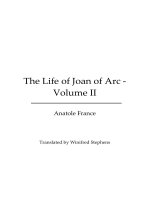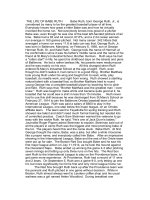The life of crustacea
Bạn đang xem bản rút gọn của tài liệu. Xem và tải ngay bản đầy đủ của tài liệu tại đây (18.96 MB, 414 trang )
R ARIES
NOUnillSNI NVINOSHlll^S
SMITHSONIAN INSTITUTION
r-
2:
S3 HVd 8 n""L B RAR ES
NVINOSHIIWS
inillSNl
z:
iniiiSNi
^
NviNOSHiiiAis
r-
.
r-
-z.
I
J
I
c/>
2^
2
S3idvaan r- libraries
.;..*•
^
Z
SMITHSONIAN
2
Smithsonian
f^
o
CO
E
ARIES SMITHSONIAN INSTITUTION NOIiniUSNI NVINOSHillMS
Z
z •
^
^
C/^
R
t/>
^
XnillSNI
NVINOSHXms'^Sa d Vd a n^LI BRAR Es'^SMITHSONIAN
I
I
z
-J
z
_
3RARIES SMITHSONIAN INSTITUTION NOUnillSNI NVINOSHIIWS
r2:
Z
r-
;
c
f
'^f^m^
z
_
bVaan LIBRARIES
J
SMITHSONIAN
z
INSTITUTION
NOIiniliSN
CD
TO
>
ITUTIOn"^ NOIinillSNrMVlNOSHilWS
SaiilVdail LIBRARIE
HVdan^LIBRARI ES'^SMITHSONIAN
INSTITUTION
ITUTION
NOIiniUSh
-I
2
Z
_j
NOliniliSNI NlVINOSHimS SBIdVdail LIBRARIE
rz
rZ
^
,
.
s
~
'
C/5
avdan z libraries w Smithsonian
^
2
CO
institution
LIBRARIE
INSTITUTION
NOIinillSr
NVIN0SHiltMs'^S3
dVdan LIBRARIES
SMITHSONIAN
R>..
Vd a
11
ITUTION'^NOIinillSNI
^^v^
NOliniliS^
(/)
*
I
d
THE LIFE OF CRUSTACEA
^%y
^^
*^''-"%!^
'%:%
^
^c.
>V^
t-^LIFE
^^"j"^
W.
THE
OF CRUSTACEA
T.
G©py
GALMAN,
hio,
D.Sc,
E^ (y/3.
WITH THIRTY-TWO PLATES AND EIGHTY-FIVE FIGURES
METHUEN & CO. LTD.
36 ESSEX STREET W.G.
LONDON
INVERTEBRATE
\ZOOLOGY
Crustacea
First Published in igii
PREFACE
npHIS
sketch of
the
Natural
History of
the
Crustacea deals chiefly with their habits and
modes
of
life,
and attempts
to provide, for readers
the technicalities of Zoology, an
unfamiliar with
account of some of the more important
scientific
problems suggested by a study of the living animals
in relation to their
I
am
environment.
indebted to the Trustees of the
Museum
for leave to
British
reproduce certain figures pre-
pared for the " Guide to the Crustacea, Arachnida,
Onychophora,
and
Myriopoda
Department of Zoology";
kester,
Black
also
exhibited
to Sir
in
the
Ray Lan-
K.C.B., F.R.S., and to Messrs. A. and C.
for the use of a
volume on Crustacea
edited by Sir
Ray
number
in the
of figures from
my
"Treatise on Zoology,"
Lankester.
THE
vi
The
LIFE OF CRUSTACEA
source of these figures
explanation
attached to each.
illustrations,
some
of
specimens
Museum
;
in
indicated in the
is
Of
the remaining
are reproduced from photographs
the
collection
the others have been
of
the
British
drawn from Nature,
or copied from the original figures of various authors,
by Miss Gertrude M. Woodward,
much
indebted for the care and
to
skill
whom
I
am
which she has
given to their preparation.
W.
T. C.
CONTENTS
CHAPTER
I.
II.
Introductory
The Lobster
......
as a Type of Crustacea
PAGE
i
-
-
6
III.
The Classification of Crustacea
-
-
-
34
IV,
The Metamorphoses of Crustacea
-
-
-
66
-
-
-
88
.
-
-
ny
.
-
138
157
V. Crustacea of
the Seashore
VI. Crustacea of the
VII. Floating
VIII.
IX.
Deep Sea
-
-
'
Crustacea of the Open Sea
Crustacea of Fresh Waters
-
.
.
-
Crustacea of the Land
-
.
.
.
188
-
207
-
237
-
256
Crustacea as Parasites and Messmates
X.
XI, Crustacea in Relation to
XII.
Crustacea of the Past
Appendix
I.
-
...
Man
.
-
:
-..-...
.--..---
Methods of Collecting and Preserving Crus.
tacea
II.
Index
Notes on Books
.
Vll
-
.
.
.
271
277
280
OF ILLUSTRATIONS
IN THE TEXT
LIST
......
.......
----..-
FIG.
1.
The Common Lobster
2.
One OF THE Abdominal Somites of the Lobkter, with
3.
ITS Appendages, separated and viewed from in
Front
Third Maxilliped of Lobster Walking Legs of Lobster
Appendages of Lobster in Front of Third Maxil-
FROM THE Side
4.
5.
6.
7.
-
-
liped
Dissection of Male Lobster, from the Side
Gills of the Lobster, exposed by cutting away the
Side-flap of the Carapace (Branchiostegite)
First Larval Stage of the Common Lobster, x 4 Side view of Rostrum of (A) Common Lobster
{Homarus gammarus) and (B) American Lobster
[Homarus americanus)
-
8.
9.
y
g
11
12
13
16
18
28
-
-
10.
The "Fairy Shrimp"
11.
Estheria ohliqua,
12.
Daphnia pulex,
13.
Much enlarged Shells of Ostracoda.
14.
Cyclops alhidus, a
15.
Nebalia
16.
Mysis
17.
Gnathophausia
Water
bipes.
relicta,
-
One of the Conchostraca
a Common Species of "Water-flea."
-
-
-
35
36
-
-37
-
-
38
Species of Copepod found in Fresh
-
-
-
Enlarged One of the Mysidacea,
-
-
-
-
-
-
-
44
-
47
Enlarged
willemoesii, One of the Deep-sea MysiHalf Natural Size
goodsiri, One of the Cumacea.
Enlarged
dacea.
Diastylis
-
Much enlarged
32
Male.
[Chirocephalus diaphanus),
X 2
8,
PAGE
{Homarus gammarus), Female,
-
ix
-
-
39
-
48
-
49
THE
LIFE OF CRUSTACEA
PAGE
20.
One of the Tanaidacea. Enlarged
A WooDLOUSE {Porcellio scaber), One of the Isopoda.
21.
An Amphipod {Gammarus
22.
Two
19.
Enlarged
23.
50
Apseudes spinosus,
-
-
-
-
Enlarged
locusta).
Species of Caprellid^e
thf
of
Whale-louse
the
Paracyamus boopis,
back
Whale
-
-
-
24. Meganyctiphanes norvegica,
-
-
-51
-
-
53
-
54
-
Hump-
-55
-
One of the Euphausiacea.
26.
Twice Natural Size
Larval Stages of the Common Shore Crab {Carchtus
mcBnas see Plate IX.)
Last Larval Stage of the Common Porcelain Crab
27.
First Larval Stage of Munida rugosa (see Plate VL)
28.
The Phyllosoma Larva of the Common Spiny Lobster
29.
Much enlarged
{Palinunis vulgaris— see Plate V.).
Larval Stages of the Prawn PencBiis (see Plate IV.).
30.
Newly
-
25.
—
-
-
-
{Porcellana longicornis—SEE Fig. 41, P. 113).
-
X 10
-
-
-
-
x 9
-
-
5^
-
68
-
70
-
71
72
X 45
31.
32.
34.
36.
Crayfish
-
-
{Astaciis
-76
-
Much enlarged
Early Larval Stage of a Species of Squilla, prob-
5. dubia.
-
-
x 10
-
-
-
-
-
78
-
-
-
80
Larval Stages of the Brine Shrimp {Artemia salina)Early Nauplius Larva of a Copepod (Cyclops). Much
enlarged Larval Stages of the Common Rock Barnacle
{Balaniis balanoides— see Plate III.)
A Common Hermit Crab {Eupagiivus bernhardtis) removed
from the ShellPylocheles miersii, a Symmetrical Hermit Crab
(Female), a Sand - burrowing
stebbingi
Callianassa
Thalassinid from the South Coast of England.
Natural Size
The Common Sand-hopper {Talitrus saltator), Male,
from the Side, x 3
-
35.
a
Young Specimen of an African River Crab {Potamon
johnstoni), taken from the Abdomen of the Mother.
ably
33.
74
hatched Young of
Enlarged fluviatilis).
-
-
-
-
-
-
-
-
-
37.
38.
-
39.
-
-
81
82
83
91
-
-
94
-
-
103
-
108
LIST OF ILLUSTRATIONS
xi
PAGE
FIG,
Sea-weed {Halimeda) B, a
Crab {Huenia proteiis) which lives among the Fronds
OF Halimeda, and closely resembles them in Form
AND Colour. ReducedThe Common Porcelain Crab [Porcellana longicornis),
slightly enlarged, and One of the Third Maxillipeds detached and further enlarged to show
THE Fringe of Long Hairs
A Deep-sea Lobster {Nephropsis stewartii), from the
.
.
Bay of Bengal. Reduced
Munidopsis regia, a Deep-sea Galatheid from the Bay
OF Bengal. Reduced -
40. A,
41.
42.
A Piece of a Tropical
;
-
-
-
no
-
-
-
113
-
43.
...
44.
Thaiimastocheles zaleucus.
45.
A Deep-sea Crab
48.
50.
51.
52.
53.
55.
56.
129
Reduced
-----
131
-
144
-
One of the Eryonidea, Female,
A Female
the Family Lepadid^, showing greatly-developed
Spines. From a Specimen taken in the Atlantic
Ocean, near Madeira, x ii Calocalaniis pavo, One of the Free-swimming Copepoda
OF THE Plankton. Enlarged
Copilia qtiadrata (Female), a Copepod of the Family
CORYC^ID^, SHOWING THE PaIR OF LarGE "TELEx 20
-
-
-
145
146
-
147
-
-
148
-
-
153
colletti,
-
X 50
135
-
Male. From a Specimen taken in
Deep Water near the Canary Islands, x 12
The Brine Shrimp {Artemia salina)
Chydoms sphcsricus, a Common Species of Water-flea.
Phronima
133
Specimen seen from the
Side and from Below, showing the Distendedballoon-like Form of the Anterior Part of the
Body, x 3
The Zoea Larva of a Species of Sergestes, taken by
the " Challenger " Expedition, x 25
The Nauplius Larva of a Species of Barnacle of
SCOPIC " Eyes,
54.
123
-
-
FROM the Indian Seas
Eryon propinqmis, One of the Fossil Eryonidea, from
THE Jurassic Rocks of Solenhofen Conchcecia curta, an Ostracod of the Plankton,
x 40
49. Mimonectes loveni.
122
-
Reduced
[Platymaia ityville-thonisoni).
46. Polycheles phosphorus,
47.
-
-
-
-
-
-
-
-
154
164
166
THE
LIFE OF CRUSTACEA
57.
A Water-flea
{Daphnia pulex), Female, with
58.
Bythotrephes longmanus,
xii
PAGE
FIG.
piUM containing
Brood-sac.
Ephip-
Two "Resting
Eggs." x 20
Female, with Embryos in the
-
x 12
-
-
-
-
-
63.
Female, x 25
Asellus aqtiaticus, Female,
x 4
Map showing the Distribution of Crayfishes
A Well Shrimp (Niphaygus aqiulex). x 7
The Sea-slater {Ligia oceanica). About Twice Natural
64.
Structure of the Breathing Organs of
59.
60.
61.
62.
Diaptomiis casruleus,
-
scaher
66.
171
-
i73
.......
..-.-..
65. Armadillidium vidgare.
Two Branches
of
x 2|
a
Coral
-
-
[Seriatopora)
-
-
185
200
202
203
showing
69.
70.
Cirolana borealis.
68.
175
Poycellio
"Galls" inhabited by the Crab Hapalocarcinus
marsiipialis.
On the Right the Female Crab,
EXTRACTED FROM THE GaLL AND FURTHER ENLARGED
Hyperia galba, Female. Enlarged
A, The Crab Melia tessellata clinging to a Branch of
Coral, and carrying in Each Claw a I.iving Seaanemone B, One of the Claws further enlarged
TO show the Way in which the Anemone is held
The Common Pea Crab {Pinnotheres piston), Female.
67.
169
-
-
Size
167
-
211
213
;
Natural Size
71.
...--.
216
217
About Twice Natural Size A, Front Part of Body of a Prawn [Spirontocavis
polaris), from Above, showing on the Right Side
A Swelling of the Carapace caused by the
Presence of the Parasite Bopyroides hippolytes in
the Gill Chamber
B, the Female Parasite
EXTRACTED AND FURTHER ENLARGED
C, THE MaLE
Parasite on Same Scale as the Female
-
2'22
A
Fish-louse {Caligtis rapax), Female, x 5
Stages of Development of Lerncea branchialis. F is
SLIGHTLY, THE OtHER FIGURES GREATLY, ENLARGED Stages of the Life-history of Hamocera dana, One
OF THE MONSTRILLID^
Free - swimming Stages of Sacculina carcini. Much
225
-
219
;
;
-
72.
73.
74.
-
-------
75.
ENLARGED
.
.
226
229
232
LIST OF ILLUSTRATIONS
.....--
FIG.
76.
77.
xiii
Early Stage of Sacculina within the Body of a
Crab
Rostrum and Fore Part of Carapace, seen from
Above, of (A) Red clawed Crayfish {Astacus
fluviatilis) and (B) White-clawed or English Cray-
PAGE
234
-
fish [Astacus
pallipes)
.
.
.
.
.
79.
The Common Shrimp (Crangon vulgaris). Natural Size
The Norwegian Deep-water Prawn {Pandalus borealis),
80.
Female
The Gribble
78.
81.
-..-.-{Limnoria
Much enlarged
lignoriini).
-
Restoration of a Trilobite (Triarthrus becki), showing
THE Appendages. Upper Side on Right, Under
Side on Left. Slightly enlarged Ceratiocaris papilio, One of the Fossil Phyllocarida
Under
Pygocephalus cooperi, from the Coal-measures
Side of a Female Specimen, showing the Overlapping Plates of the Brood-pouch
The Tasmanian "Mountain Shrimp" {Anaspides tasmanics), a Living Representative of the Syncarida.
.
.
.
.
Slightly enlarged
Pr^anaspides pyacursor, One of the Fossil Syncarida,
from the Coal-measures of Derbyshire, Slightly
enlarged
-
82.
83.
84.
85.
242
244
246
254
258
-
262
-
263
:
-------
264
265
FULL-PAGE PLATES
FACING PAGE
PLATE
I.
Male and Female Lobsters, showing the Difference IN the Relative Breadth of the Abdomen
IN THE Two Sexes. This Figure also illustrates
the Dissimilarity of the Large Claws, and the
Fact that the "Crushing Claw" may be on
either the Right or Left Side of the Body.
(From
IL Apus
Brit.
Mus. Guide)
-
-
-
-26
--.----
cancriformis
ENLARGED
-
from Kirkcudbrightshire.
Slightly
63
THE
xiv
LIFE OF CRUSTACEA
PLATE
FACING PAGE
Group of Specimens
the Goose Barnacle'
{Lcpas anatifera), One showing the Cirri extended AS IN Life. Natural Size. {From Brit.
^
III.
of
Mus. Guide)
i
^
42
Group of a Common Species of Acorn-shell or
Rock Barnacle {Balanics balanoides). Natural
Size
IV.
j
PencBus caramote,
{From
Size.
The Common Spiny Lobster
V.
Much
Munida
VI.
reduced.
{From
British.
rugosa.
About
from the Mediterranean.
Half Natural
Brit.
Brit.
Mus. Guide)
{Palinurus
Mus. Guide)
Reduced
-
57
-
vulgaris).
-
-
-
-
59
60
The Common Hermit Crab, Eupagurus bernhardiis, in
the Shell of a Whelk. Reduced. {From Brit.
VII.
Mus. Guide)
-
62
Stone Crab," Lithodes maia.
reduced.
The Last Pair of Legs are
folded out of Sight in the Gill Chambers.
{From Brit. Mus. Guide)
-
63
'The Common Shore Crab {Carcinus manas). Reduced
IX.
Dromia vulgaris, carrying on its Back a Mass of
THE Sponge, Clione celata. British. Reduced
68
The
VIII.
-
-
-
-
-
"Northern
Much
Reduced
X.
Calappa flammea.
XI.
The Giant Japanese Crab, Macrocheira kampferi.
Male. The Scale of the Figure is given by
A Two-foot Rule placed below the Specimen.
XII.
{From
Brazil,
Mus. Guide)
-
-
72
-
-
76
from the Mediterranean. About
One-half Natural Size. {From Brit. Mus. Guide)
80
Brit.
-
-
Sqidlla mantis,
Swimming Crab, Portunus
XIII. J[
j
depurator.
British.
Reduced
"^^
^—
A
Spider Crab, Maia squinado, dressed in Fragments of Weeds. British. Reduced
I
q6
LIST OF ILLUSTRATIONS
XV
FACING PAGE
{Corystes cassivelatmiis. Male (on Left) and Female^
(on Right).
British. Reduced
Albunea sytmiista, One of the Hippidea. Indian
I
j
Reduced
Seas.
(Ocypode cursor.
XV.
Gelasimus
-|
[^
West Africa. Reduced
Male above, Female
below.
tangeri.
West
104
Reduced
Africa.
A Deep-sea Hermit
XVI.
j
Crab, Parapagurtis
pilosimanus,
sheltered by a Colony of Epizoanthus. From
Deep Water off the West of Ireland,
Slightly reduced
-----
124
sea Prawn, Nematocarcinus undulatipes.
Slightly reduced. {Frojn Brit. Mus. Guide)
128
A Deep
XVII.
-
Bathynomus
{From Lankesters
Size.
after
About One-half Natural
giganteus.
"Treatise on Zoology,"
Milne-Edwards and Boiivier)
131
elegans, One of the Dromiacea which
resembles
a
Spider
Crab.
From the
Mediterranean. Natural Size
The Gulf-weed Crab, Planes minutns. Slightly
enlarged
Latreillia
XIX.
The
XX.
Murray
-^
The Land Crayfish,
EngcBus
Astacopsis
Much reduced
Tas-
cunicularis.
Y
177
Natural Size
mania.
A Large Freshwater
Prawn of the Family Pal^monid^. West
XXI.
Palamion
jamaicensis.
Indies.
XXII.
Atya
Much reduced
scabra.
I
.
-
.
A Freshwater Prawn
Family Atyid^e.
XXIII.
" Lobster,"
River
New South Wales.
spinifer.
155
West
Indies.
of
Reduced
-
the
-
The River Crab of Southern Europe, Potamon
Reduced
edule (or Telphusa fluviatilis).
Sesarma chiragra. A Freshwater Crab of the
Family Grapsid^e. From Brazil. Slightly
reduced
179
180
182
THE
xvi
LIFE OF C^RUSTACEA
FACING PAGE
PLATE
XXIV.
XXV.
j^glea
South America.
Icsvis.
-.-...
'A
West
Natural
pellucidus.
186
ruricola."
Reduced
A Land Hermit
Crab,
Coenohita
-
Re
rugosa.
190
----..
ig6
Group of Barnacles, Corontda diadema, on the
Skin of a Whale. Japan, Reduced
209
The Coco Nut Crab,
duced
XXVIII,
Camhavus
Indian Land Crab, Gecarcinus
duced
XXVII.
184
-
The Blind Crayfish of the Mammoth Cave
OF Kentucky,
Size
XXVI.
Natural Size
Birgus
latro.
Much
re-
-
!Cymothoa
oestrum.
An Isopod Parasite of
Fish.
Slightly enlarged
carcini attached under the Abdomen
Saccidina
OF A
XXX.
Common Shore Crab.
The " Norway Lobster," Nephrops norvegicus.
About One-third Natural Size, {From Brit.
Mns. Guide)
XXXI.
The
Common
British.
XXXII.
Reduced
.
Edible
.
Crab,
Much reduced
_
Cancer
-
.
.
240
pagurus.
-
-
Piece of Timber from Ryde Pier, showing
Damage caused by Limnoria and Chelura.
{From Brit. Mns. Guide)
.
-
248
255
THE LIFE OF CRUSTACEA
THE LIFE OF CRUSTACEA
CHAPTER
I
INTRODUCTORY
EVERYONE
has some acquaintance with the
animals that are grouped by naturahsts under
the
name
Crustacea.
The
Prawns,
and Shrimps, are
familiar,
either
as
edible Crabs, Lobsters,
least
at
brought
to
displayed in the fishmonger's,
the
superficially
table
or
as
and the most unhad his
observant of seaside visitors must have
attention attracted by living specimens of
some
the more obtrusive species, such as the
common
Shore Crab.
Many, however,
will
of
be surprised to
learn that the Barnacles coating the rocks on the
and the
Woodlice of our gardens, are members of the same
Still less is it suspected, by those who have
class.
seashore, the Sand-hoppers of the beach,
not given special attention to the subject, that the
living species of the
group number
many
thousands,
presenting strange diversities of structure and habits,
and playing important parts
of Nature.
in the general
economy
LIFE OF CRUSTACEA
THE
2
In addition to those just mentioned, a few Crus-
tacea are sufficiently well
by popular names, such,
and Hermit Crabs, but
names
available
are
zoology.
In
known
to be distinguished
example, as Crayfish
for
majority
for the vast
except
those
of
no
technical
following pages, therefore, while
the
technical terms have been introduced as sparingly
as possible, the unfamiliarity of the animals themselves
makes
needful to use
it
many
unfamiliar
names.
In the classification of the Animal Kingdom, the
Crustacea form one of the divisions of a comprehensive group,
The
typical
or
Phylum, known as Arthropoda.
of this group have a more or
members
body is divided into
segments, there are jointed limbs, and some of these
less firm external skeleton, the
are modified to serve as jaws.
or
classes
cluding
Beetles,
(iii.)
of
The
the Arthropoda are
Moths,
Butterflies,
and the
like
;
(ii.)
—
chief divisions
(i.)
Wasps,
Bees,
Diplopoda, or Millipedes^;
It is
^
;
and
;
(v.)
Arach-
their allies
;
Crustacea.
not easy to summarize in a few words the
characters
ing
Flies,
Onychophora, in-
(iv.)
cluding the curious worm-like Peripatus
(vi.)
in-
Chilopoda, or Centipedes
nida, or Scorpions, Spiders, Mites,
and
Insecta,
common
to all Crustacea,
them from the other groups
The Chilopoda and Diplopoda
forming a single class
— Myriopoda.
and distinguishAs
of Arthropoda.
are sometimes regarded as
INTRODUCTORY
a rough guide to classification,
it is
3
remember
useful to
that an Insect can generally be recognized by having
three pairs of walking legs, an Arachnid by having
four pairs,
great
and a Centipede or Millipede by having a
many
The
pairs, all nearly alike.
Crustacea,
on the other hand, show great diversity
and arrangement of
their walking or
in the number
swimming legs,
but they rarely show any special resemblance to those
of the other large groups of Arthropoda.
example, a
common
lidumi vulgare,
very similar at
is
Thus,
for
species of Woodlouse, Armadil-
Millipede Glomeris marginata, but
first
it
sight to the
has only seven
pairs of walking legs, while the Millipede has seven-
teen or nineteen pairs.
More
precisely,
it
may
be said of the great majority
of Crustacea that they are aquatic animals, breathing
by
gills or by the general surface of the body, having
two pairs of " feelers," or antennae, on the front part
of the head, and at least three pairs of jaws.
Excep-
tions to each of these statements will be
highly modified types.
mentioned
with parasites and other
in later chapters in dealing
In such cases, however, the
young stages afford indications of affinity,
and comparison with less modified forms enables us
larval or
to trace a connection with the typical Crustacea.
The
best
way
to form a conception of a group ot
animals, however,
is
not to attempt in the
to define its limits, but to
structure of
some
typical
first
place
begin by studying the
and central
species,
and









